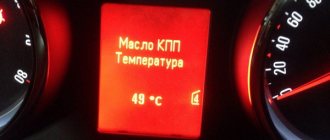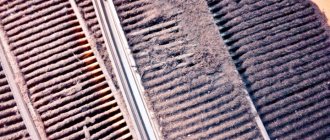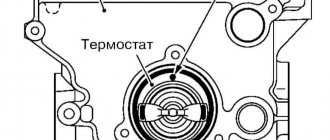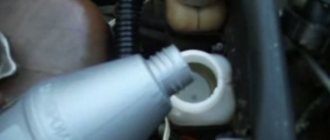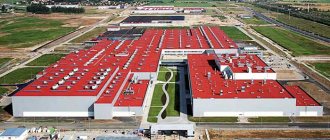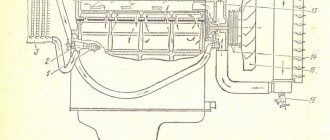To clean the windshield of a car in winter, when the temperature outside often drops below zero, you cannot pour ordinary water into the windshield washer reservoir - it will simply freeze.
In the cold season, car owners traditionally change the water to anti-freeze.
However, some drivers use anti-freeze all year round, and therefore do not worry about sudden changes in weather.
It's easier to buy antifreeze. However, if this is not possible (for example, you went to a remote village where there have never been any auto shops), then there is only one way out - to prepare antifreeze liquid with your own hands.
Is it difficult? Probably not. The main thing is to know what ingredients to use for this, and in what proportions
they need to be mixed so that you get exactly the anti-freeze for glass, and not some strange mixture with a “vigorous” smell.
If you bought anti-freeze at a car dealership and it has a strong, unpleasant odor, it is most likely made from isopropyl alcohol.
As a rule, such mixtures are the cheapest, which is why many drivers fall for them.
It’s better to fork out a little and buy a winter washer based on ethyl alcohol. Today this is the best option.
Well, if you don’t want to support washer manufacturers, then we’ll tell you how to make an anti-freeze
at home.
We would like to warn you right away: it is not enough to simply mix the first ingredients that come to hand “by eye”.
In order for the anti-freeze to perform its main functions (clean glass and not freeze at temperatures below 0 degrees), it is important not only to use the correct components, but also to mix them in strictly defined proportions
.
Ingredients
All ingredients are on the table.
You can start the experiment. All ingredients are on the table. You can start the experiment.
The composition of any antifreeze includes alcohol (the more of it, the lower the freezing point), water, surfactants (surfactants), fragrance and dye. Elementary! The most expensive alcohol is ethyl, ethanol. It is used in medicine and can be drunk. The anti-freeze products we buy are made mainly from inexpensive isopropyl alcohol, isopropanol, obtained by hydrogenating acetone or hydrating propylene. It is not advisable to drink it. Methyl alcohol, methanol, from which antifreezes are made abroad, cleans well, but has been banned in Russia for 10 years. Why? Some individuals tried to drink it with sad results.
6). Liquid for glass based on medical alcohol
We can say that this is traditional and our way. To prepare this liquid, i.e. your own antifreeze, you can use medical alcohol.
To prepare 3.75 liters of liquid, you will need to take 3 glasses of 250 grams of pure 70% alcohol (650 grams of alcohol - when using pure alcohol 96.6%) and mix it with 10 glasses of clean water (each glass is 300 grams).
After this, add 1 tablespoon of washing powder to the resulting liquid.
Also mix everything thoroughly.
production of antifreeze liquid
Pour 2 liters from a jar of water.
For accuracy, we use a measuring container. Pour 2 liters from a jar of water. For accuracy, we use a measuring container.
Alcohol and other ingredients can be bought absolutely legally, and we will mix the solution for ourselves, and not for sale. Nothing illegal. The standard volume is 5 liters. We reject methanol right away - there are no people willing to check the words of the country’s former chief sanitary doctor Gennady Onishchenko that at high concentrations its vapors can cause blindness. What remains is isopropanol and ethanol. We take the latter: it is less viscous, more fluid, and if the experiment fails, we will find a use for the remains. Only wipe the contacts with isopropanol.
4). Windshield wiper fluid with ammonia
To make windshield cleaner from ammonia, you will need to mix 1 part ammonia with 3 parts clean water.
For example, for 1 liter of liquid you will need 335 ml of ammonia and 665 ml of clean water, which will need to be thoroughly mixed with each other. Attention! When mixing, be careful not to foam.
We immediately warn you that the liquid obtained in this way cannot be used at very low air temperatures. And to use it in severe frost, you will need to add 50 - 100 grams of vinegar to the liquid (possibly with flavoring).
production of antifreeze liquid
...dishwashing detergents are already free creativity, high precision is not necessary.
...dishwashing detergents are already free creativity, high precision is not necessary.
Dilute water with alcohol according to the table below. Since we want to get a freezing point below -27°C, we take 2 liters of alcohol for 3 liters of water. Next, pour in the blue and a few drops of dishwashing detergent (they also contain water), and sprinkle cologne (a bit of alcohol) into the jar. Mix.
3). Windshield fluid made from vinegar
Attention!!! This method can only be used, friends, at ambient temperatures ranging from -10 degrees below zero, otherwise, when using this product with vinegar, there will be a disgusting smell in the car interior.
To prepare this liquid, you will need to mix vinegar and clean water in equal proportions. For example, to prepare 1 liter of anti-freeze liquid, you need to thoroughly mix 500 ml of vinegar and 500 ml of clean water.
anti-freeze
Blue in the solution before and after mixing.
Blue in the solution before and after mixing.
To check what we got, we left the solution overnight in an industrial freezer, capable of freezing even vodka. The next morning we open it with our hands trembling due to excitement. Bah! The solution separated a little (the concentration of blue at the bottom is slightly higher) and the liquid became a little more viscous, but it did not freeze into the ice. Already good.
Table of percentages of alcohol concentration and freezing point of liquid
When preparing liquid at home, you should take into account the temperature conditions in which it will be used, and from this calculate the proportions of the components.
The composition of an alcohol-based antifreeze is calculated as follows:
- At T -50 C – alcohol should be about 113 ml/1l of purified water;
- -100 C – 200 ml;
- -150 C – 260 ml;
- – 200 C – 300 ml;
- -250 C – 350 ml;
- -350 C – 470 ml;
- – 400 C – 560 ml;
- – 500 C – 700 ml.
Detergent is added at the rate of: per 3 liters of liquid – 1 tbsp. l.
- Google+
- LJ
- Blogger
Before pouring the prepared solution into the washer solution, you need to check its quality. To do this, the liquid is poured into a small container and left in the cold for 8-10 hours. If pieces of ice do not appear in it and it has not become gel-like, then the DIY washer is suitable for use.
- Google+
- LJ
- Blogger
antifreeze liquid
Even after a long “wintering” in the freezer of a regular household refrigerator, the solution does not lose its properties at all.
We move the antifreeze into an industrial freezer. Even after a long “wintering” in the freezer of a regular household refrigerator, the solution does not lose its properties at all. We move the antifreeze into an industrial freezer.
1). Anti-freeze from window cleaning products
To make your own “anti-freeze” you need to mix any household alcohol-based glass or window cleaner with clean water in a 1:2 ratio (one part glass cleaner, two parts water).
For example, to make your own anti-freeze in the amount of 1 liter, you will need to take 335 grams of window cleaner and add 665 grams of clean water to it.
Making an antifreeze with your own hands
Made from isopropyl alcohol.
To prepare antifreeze with your own hands using isopropyl alcohol, proceed as follows:
- Prepare 150 grams of 70 percent or 125 grams of 90 percent alcohol;
- Pour the prepared liquid into a special container;
- Add water until the volume of the finished liquid reaches 4.5 liters;
- Mix the composition until a single substance is formed.
From medical alcohol.
Many car owners, in order not to waste time searching for ingredients, use classic medical alcohol.
The algorithm for creating an anti-freeze in this case is as follows:
- Prepare 750 ml of 70% rubbing alcohol. If you managed to get 96 percent liquid, then 650 ml will be enough;
- Pour alcohol into a container with three liters of water;
- Add washing powder (one tablespoon is enough);
- Move everything. But act without fanaticism, so as not to whip the composition into foam.
Liquid with methanol (caution: poison).
One of the options for making antifreeze is the use of methanol. When using this option, it is important to be careful, because methanol is dangerous to health and is considered a poison.
If you decide to use such a composition, proceed with caution and avoid any contact of methanol with mucous membranes.
In addition, alcohol vapors should not enter the respiratory tract.
To make a composition for washing glass with your own hands, proceed as follows:
- Decide on the volume of antifreeze that will be needed (for example, one liter);
- Pour 100 ml (1/9 part) into a container;
- Add 900 ml (9/10 parts) water;
- Pour a tablespoon of dish cleaning powder (one option is Pemolux Biolan);
- Mix everything.
From vinegar.
Many car owners use vinegar, which can always be found in the kitchen. This option is simple, but not always effective.
A vinegar-based anti-freeze liquid will turn into ice when the temperature drops below 10 degrees below zero.
If you make the composition more concentrated, the smell in the cabin will be unbearable.
DIY cooking algorithm:
- Decide on the volume (for example, two liters);
- Mix water and vinegar in an identical proportion of 1 to 1;
- Mix the finished mixture and pour into the tank.
Windshield wiper fluid from window cleaner.
If you have window cleaning liquid at home, you can use it when creating an anti-freeze.
Here's the algorithm:
- Decide on the required amount of anti-freeze. Consider the option for 3 liters;
- Pour water and glass washing liquid into the container in a ratio of 2 to 1. In our case, you will need one liter of detergent and two liters of clean water;
- Mix the finished mixture.
With ammonia.
Another option is to use it for the production of ammonia (if one is available).
Algorithm for preparing anti-freeze:
- Prepare everything you need, decide on the volume (example, 3 liters);
- Pour 1 liter of ammonia (1/3 part) into a container;
- Add clean water (2 liters - 2/3 liquid);
- Mix the composition without fanaticism to prevent foaming;
- Add vinegar to the composition if you plan to operate the car in extreme cold. Otherwise, the antifreeze may turn into ice;
- To improve the smell, add fragrance.
Windshield wiper liquid from dishwashing detergent.
Almost every apartment has dishwashing liquid. It can also be used to make anti-freeze.
Algorithm for doing the work yourself:
- Pour 3.25 liters of water into the container;
- Add dishwashing detergent (a tablespoon is enough);
- Mix the composition. Be careful to avoid foaming.
Remember that the quality of the finished composition directly depends on the effectiveness of the dishwashing detergent used. So it is advisable to buy proven formulations.
If you fill in cheap liquid, it may freeze when the temperature drops below zero.
To avoid problems, before preparing anti-freeze, you should expose the detergent composition to frost and check whether it turns into ice or not. One of the proven options is the use of Fairy Platinum.
Using vodka to make anti-freeze.
One of the easiest ways to create a non-freezing liquid with your own hands is to use vodka.
This option is considered a last resort for the car owner when the antifreeze is over, but it is necessary to continue driving.
But there is a minus here - vodka is more expensive than ready-made washer fluid.
You can use another option - buy moonshine or “scorched” vodka, which is cheaper due to the use of ethyl alcohol.
But even in this case, it is important to remember that vodka freezes at 27 degrees below zero, so its use in the northern regions is limited.
Method number 5 - add ammonia
Sometimes motorists prefer to make a solution by adding ammonia to it. Here you should adhere to a ratio of 1:3 (one part ammonia to 3 parts water). When preparing the mixture, try to prevent the formation of foam. The main disadvantage of this solution is that it is strictly not recommended to use it if the temperature drops significantly; it will quickly freeze. To prevent this from happening, you can try adding about one hundred grams of vinegar to the composition.
Method No. 7 - add methanol
Methanol is also a non-freezing alcohol, but it is an extremely harmful substance for humans. When deciding to prepare such a mixture, you need to be extremely careful and avoid getting it on the skin or in the respiratory tract. This toxic liquid should be mixed with water as follows: 900 ml. add no more than 100 ml of water. methanol.
Making your own windshield washer fluids can save you some money in the long run, but it requires some knowledge and care on the part of the car owner. Thus, only you can decide what is better: buy a ready-made solution or prepare it yourself.
conclusions
When making your own antifreeze liquid, it is highly advisable to use distilled water. This measure will protect the nozzles and washer pump from deposits of mineral salts.
The most effective are mixtures based on isopropyl or ethyl alcohol when produced in-house. Although the total cost of our own product is somewhat high, its quality is an order of magnitude higher than its factory counterparts.
It is imperative to check the resistance of the liquid to low temperatures by testing a small amount of the finished emulsion. In case of freezing or thickening, you need to boost its properties by adding an alcohol-containing substance. Labeled canisters must be stored out of the reach of children and animals.
ACIDS
Let's start with the most interesting nonsense that one of my readers - viewers recently sent me. In general, what’s the point - for three liters of water, add a liter of vinegar and “voila” - you get four liters of CHEAP anti-freeze - isn’t it a miracle remedy?
Guys, honestly, are you serious? Vinegar - aka acetic acid, is still an acid!!! (You could also fill it with sulfur; by the way, the batteries have electrolyte and it doesn’t freeze down to -60 degrees)
And this is the solution you want to pour on your car? Are you serious now?
Well, yes, I saved 500 rubles over the winter this way, and in the spring you need to paint the car, because such an anti-freeze will damage all the paint, and there is a possibility that the rubber bands will corrode
Don’t do bullshit, don’t even think about using such compositions with your own hands! It's harmful for the car
How to properly pour anti-freeze into the cooling system?
When filling the glass washer container with anti-freeze, it is worth considering a number of tips:
- There is no need to pump out all the water - just select at least 50 percent of the volume. If the antifreeze is of high quality, the liquid will not freeze;
- It is not recommended to pour the composition right up to the neck;
- After filling the system, be sure to bleed it. This is done to expel ordinary water from the hoses, which is not capable of maintaining high temperatures. It is not difficult to understand that the liquid has dispersed throughout the system - this is noticeable by the appearance of a characteristic odor. If there is no such aroma, press the washer lever for 30-35 seconds. This time, as a rule, is enough to fill the system with an antifreeze composition.
Water instead of special liquid
In the summer and until frost, motorists can use plain water as a windshield washer without any problems. Some car owners prefer to fill the tank with distilled water, which avoids the formation of salt deposits on the glass and inside the mechanism that supplies liquid to the windshield. Considering the fact that dirt flying from under the wheels of the vehicle in front can be washed off very poorly, drivers are constantly experimenting with adding various additives to increase the cleaning effect of the composition and preparing summer windshield washer with their own hands. Since the onset of sub-zero temperatures, the tactics for preparing washer fluid have changed. Such mixtures will necessarily have to contain ingredients that prevent water from freezing - alcohol, acids, etc.
Important Tips
Making antifreeze with your own hands is a feasible task for every car owner.
In this case, you can get a large supply of special liquid and not be afraid for the glass washer system when operating the car in cold weather.
In conclusion, it is worth highlighting a number of tips that should be taken into account during the preparation process:
- To create an antifreeze, only distilled water should be used. Otherwise there is a risk of damage to the glass cleaning system. It is caused by the fact that, due to the use of ordinary water, rust and deposits appear on the glass cleaner nozzles over time. In addition, the system pump is also at risk.
- When using anti-freeze in the summer, it can be diluted with distilled water (in order to save money). With the onset of cold weather, the system must be filled with a full composition.
- Always check the finished anti-freeze (bought or homemade) for frost resistance. To do this, expose the composition to frost (for example, on a balcony). If it freezes or gels, add alcohol to improve the properties of the composition.
- It is forbidden to keep the antifreeze at home where children or animals can find it. In addition, the vapors from such liquids can be hazardous to health.
Before making an antifreeze with your own hands, think again about how relevant such work is.
If you rarely drive a car, it is easier to buy a ready-made compound in a store.
Video - do-it-yourself anti-freeze or what would be better.
ALCOHOLS
As I wrote above, this is the most sensible option (in fact, all official manufacturers are based on this option), but there is also a lot of confusion and ridiculous myths. What alcohols are currently available to us:
- Ethyl, also known as medical
- Methyl
- Isopropyl
- Formic
- Ammonia
- You can even include propylene glycol and ethylene glycol (used for the production of antifreeze or antifreeze )
HEALTHY OPTIONS . This is ethyl - methyl - isopropyl . All of them are relatively affordable, but for example, ethyl is expensive (on the Internet from 200 rubles a liter, but it goes up to 500). Isopropyl is used everywhere (but again, if you buy it in stores it costs up to 350 rubles/l.)
BUT I would like to say separately about the use of methyl alcohol . Now many people write poison - poison, you can’t inhale it, you’ll immediately feel vomiting and dizziness! And what they sell on the roads is made from methyl, it’s a fake.
Friends, I’ll say this, both methyl and isopropyl - that the one and the other are both poisonous (you definitely CAN’T drink them). But if used in a non-freezing environment, both are suitable, personally I like the methyl one (and it costs less), it doesn’t stink as much as the isopropyl one. And if you use it specifically for winter “washing”, it’s better!
“So wait, but they tell us we can’t pour it, you’ll get poisoned right away, and it’s been discontinued.” Read about the fact that it is toxic from above, nothing more than what the opponent is currently using. But they removed it because “drunks” extracted this alcohol from such anti-freeze and drank it! After all, “methyl” smells the same as ethyl, you can’t tell the difference, there’s no wild stench.
Ant and Ammonia . The first one can be found, but it’s difficult and expensive (I’ve seen somewhere from 500 rubles/liter), so it’s not needed.
Ammonia - yes - it is cheap, you can buy it easily (about 80 rubles/l.). But to make an antifreeze out of it with your own hands, you need to be able to do this! Because the first time you spray it on the windshield, tears will flow from your eyes and it will be impossible to breathe. HE disappears
Propylene glycol and ethylene glycol . Hypothetically, it can be used, it is also possible to buy, but the cost is about 300 rubles / 0.5 l. Very expensive.
"VODKA". Previously, this was popular (about 3 - 4 years ago), vodka cost 90 rubles for 0.5, and anti-freeze about 200 - 300 for 5 liters. We buy two bottles and 4l. water - here's 5 liters. up to -20 degrees. BUT now a winter washer costs from 100 rubles. for 5l., and vodka from 200r. for 0.5 – the meaning is lost.
MOONSHINE . The only thing that is really cheap and works is moonshine. If you have a device, if you have anything to drive from, then go ahead. A liter of the same (especially “primary”), for 4 liters of water. The cost is approximately 5-10 rubles (for electricity or gas).
WE STUDY THE COMPOSITION OF INDUSTRIAL PRODUCTION WASHERS
In order to make washer fluid yourself, you first need to understand the composition of industrial samples and take into account their advantages and disadvantages.
All commercially produced car detergents are usually alcohol-based. There are three types of alcohol that are added to such products:
- Methyl. The use of methyl alcohol in the manufacture of automotive and household chemicals is prohibited by the legislation of most countries, including Russia, but this does not prevent unscrupulous manufacturers from adding it to their products without appropriate instructions on the packaging.
Despite its cheapness, methyl alcohol is an extremely toxic substance, the inhalation of vapors of which in large quantities causes serious harm to health.
- Isopropyl alcohol is the most commonly used option due to the low cost of the raw material. It does not have a negative effect on the body, but at high concentrations in the detergent composition it can damage the varnish layer of the car. Anti-freeze products based on isopropyl alcohol have a sharp, unpleasant odor reminiscent of acetone;
- Ethyl alcohol is the best option in terms of the final characteristics of the detergent. It is non-toxic, does not have a pungent odor, but is expensive, which is why it is extremely rare in anti-freeze formulations.
Saving money, which is detrimental to health or the car, is not in our interests, so we will use ethyl alcohol to make the detergent.
For those who doubt whether the game is worth the candle, let’s say that do-it-yourself freezing based on ethyl alcohol will, in any case, cost us less than a store-bought product with a low-quality composition, the main part of the cost of which is the manufacturer’s markup.
About prices and feasibility
I think many will agree with me - making such a liquid with your own hands is only worth it when:
- It is cheaper than purchased options (sometimes twice as expensive)
- Safe for cars, other substances are used
- Affordable, you can buy components in any store
Only then is it worth making the anti-freeze yourself, otherwise we go to the store (or on the side of the road) and buy it. This is often more appropriate.
And here we have several options - alcohols, acids, solvents, and chemicals from the store . Let's look at each separately, leaving the alcohols last.
